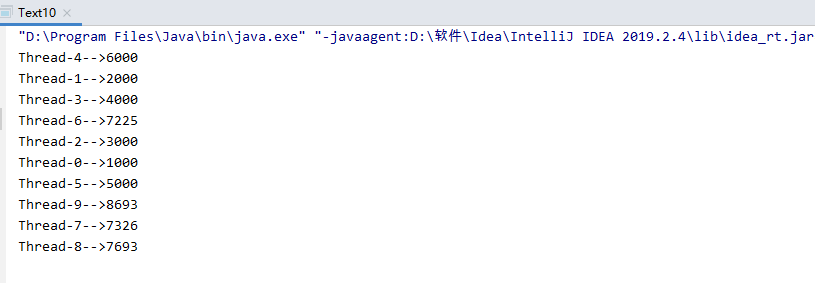轻量级同步机制:volatile关键字
volatile的作用
关键作用是使变量在多个线程之间可见
public class VolatileText {
public static void main(String[] args) throws InterruptedException {
Student student=new Student();
new Thread(new Runnable() {
@Override
public void run() {
student.GetMethon();
}
}).start();
Thread.sleep(1000);//睡眠之后修改布尔值
student.GetName(false);//改变布尔值以结束程序运行
}
static class Student
{
public boolean flag=true;
public Student GetName(boolean flag)
{
this.flag=flag;
return this;
}
public void GetMethon()
{
System.out.println("开始");
while (flag){//死循环
}
System.out.println("结束");
}
}
}

程序并没有因为我修改之后结束运行,因为线程对共享变量具有不可见性,main线程修改布尔值之后,子线程看不到值的修改。因此要想实现线程的可见性这里可以加上volatile关键字修饰公共变量
volatile关键字的作用:使线程在强制公共内存中读取变量值,保证可见性
volatile非原子特性
public class Text10 extends Thread {
private volatile static int count;
@Override
public void run() {
Addcount();
}
public static void Addcount()
{
for (int i = 0; i < 1000; i++) {
count++;
}
System.out.println(Thread.currentThread().getName()+"-->"+count);
}
public static void main(String[] args) {
for (int i = 0; i < 10; i++) {
Text10 text10=new Text10();
text10.start();
}
}
}

按道理输出1000的整数倍数才对,但是变量在自增的过程中没有更新到又被读取再修改,因此volatile不具备原子性,正确办法将方法加上synchronized关键字

volatile与synchronized比较
-
volatile关键字是线程同步的轻量级实现,所以volatile性能肯定比synchronized要好,volatile只能修饰变量,而synchronized可以修饰方法代码块,在开发中使用synchronized比例还是挺大的。
-
多线程访问volatile变量不会发生阻塞,而synchronized可能会阻塞。
-
volatile能保证数据的可见性,但是不能保证原子性,而synchronized可以保证原子性,也可以保证可见性,因为
-
synchronized会将线程的工作内存和主内存进行同步
-
volatile关键字保证多个线程之间的可见性,synchronized关键字解决线程访问公共资源的同步性。
区别 synchronized volatile 使用上 只能用于修饰方法、代码块 只能修饰实例变量或者类关键字 原子性保证 能保证,锁可以保护数据不被打断 无法保证 可见性保证 能保证,排它方式使同步代码串行 能保证,可以读取公共变量 有序性保证 能保证,在同步串行的时候 能保证,禁止JVM以及处理器进行排序 阻塞情况 会发生阻塞 不会发生阻塞
常用原子类进行自增自减操作
i++不是原子操作,除了使用synchronized进行同步,也可以使用AtomicInteger/AtomicLong进行实现
import java.util.concurrent.atomic.AtomicInteger;
public class Text10 extends Thread {
private static AtomicInteger count=new AtomicInteger();
@Override
public void run() {
AddCount();
}
public static void AddCount()
{
for (int i = 0; i < 1000; i++) {
count.getAndIncrement();//相当于i++
//count.incrementAndGet();//相当于++i
}
System.out.println(Thread.currentThread().getName()+"-->"+count.get());
}
public static void main(String[] args) {
for (int i = 0; i < 10; i++) {
Text10 text10=new Text10();
text10.start();
}
}
}

CAS
CAS(Compare And Swap)是由硬件实现的,
CAS可以将read(读)-modify(修改)-write(写)转化为原子操作
i++自增过程:
从主内存调取i变量值
对i值加1
再把加1过后的值保存到主内存
CAS原理:在把数据更新到主内存时,再次读取主内存变量的值,如果现在变量的值与期望的值一样就更新。

使用CAS原理实现线程安全计数器
public class CASText {
public static void main(String[] args) {
CASControl casControl=new CASControl();
for (int i = 0; i <10000 ; i++) {
new Thread(new Runnable() {
@Override
public void run() {
System.out.println(Thread.currentThread().getName()+"==>"+casControl.incrementAndGet());
}
}).start();
}
}
}
class CASControl
{
volatile static long value;//使用volatile修饰线程可见性
public long getValue()
{
return value;
}
private boolean Expect(long oldValue,long newValue)
{
synchronized (this)
{
if(value==oldValue)
{
value=newValue;
return true;
}
else
return false;
}
}
public long incrementAndGet()
{
long oldvalue;
long newValue;
do {
oldvalue=value;
newValue=oldvalue+1;
}while (!Expect(oldvalue, newValue));
return newValue;
}
}

CAS中的ABA问题
CAS实现原子操作背后有一个假设:共享变量当前值与当前线程提供的期望值相同,就认为变量没有被其他线程过。
实际上这种假设不一定成立,假如count=0
A线程对count值修改为10
B线程对count值修改为30
C线程对count值修改为0
当前线程看到count=0,不能认为count没有被其他线程更新,这种结果是否能被接受?
这就是CAS中的ABS问题即共享变量经过了A=》B=》A的更改
是否能够接受ABA问题跟算法实现有关
如果想要规避ABA问题,可以为共享变量引入一个修订号,或者时间戳,每次修改共享变量值,相应的修订号加1.,就会变更为[A,0]=>[B,1]=>[A,2],每次对共享变量的修改都会导致共享变量的增加,通过这个标识就可以判断。AtomicStampedReference类就是基于这个思想产生的。
原子变量类
原子类变量是基于CAS实现的,当对共享变量进行read(读)-modify(修改)-write(写)操作时,通过原子类变量可以保障原子性与可见性,对变量的read(读)-modify(修改)-write(写)操作不是指一个简单的赋值,而是变量的新值,依赖变量的旧值,如自增操作i++,由于volatile只能保证原子的可见性,而不能保证原子性,原变量类内部就是一个借助volatile变量,并且保障了该变量的read-modify-wirte操作的原子性,有时把原子变量看作一个增强的volatile变量,原子变量类有12个
| 分组 | 原子变量类 |
|---|---|
| 基础数据型 | AtomicInteger、AtomicLong、AtomicBoolean |
| 数组型 | AtomicIntegerArry、AtomicLongArry、AtomicReferenceArry |
| 字段更新器 | AtomocIntegerFiledUpdater、AtomicLongFieldUpdate、AtomicReferenceFiledUpdater |
| 引用型 | AtomicReference、AtomicStampedReference、AtomicMarkableReference |
使用AtomicLong定义计数器
import java.util.Random;
import java.util.concurrent.atomic.AtomicLong;
public class Text15 {
//构造方法私有化
private Text15(){}
//私有静态对象
private static final Text15 text=new Text15();
//公共静态方法返回该类的实例
public static Text15 getInstance()
{
return text;
}
//使用原子类记录保存请求总数 成功数 失败数
private final AtomicLong RequestCount=new AtomicLong(0);
private final AtomicLong SuccessCount=new AtomicLong(0);
private final AtomicLong FailCount=new AtomicLong(0);
//进行自增
public void RequestCount()
{
RequestCount.incrementAndGet();
}
public void SuccessCount()
{
SuccessCount.incrementAndGet();
}
public void FailCount()
{
FailCount.incrementAndGet();
}
//查看总数
public long GetRequestCount()
{
return RequestCount.get();
}
public long GetSuccessCount()
{
return SuccessCount.get();
}
public long GetFailCount()
{
return FailCount.get();
}
}
class Text16
{
public static void main(String[] args) throws InterruptedException {
new Thread(new Runnable() {
@Override
public void run() {
for (int i = 0; i <1000 ; i++) {
Text15.getInstance().RequestCount();//请求数量
int num=new Random().nextInt();
if(num%2==0)//如果是偶数就成功
{
Text15.getInstance().SuccessCount();
}
else
Text15.getInstance().FailCount();
}
}
}).start();
Thread.sleep(1000);
System.out.println("请求总数:"+Text15.getInstance().GetRequestCount());
System.out.println("请求成功"+Text15.getInstance().GetSuccessCount());
System.out.println("请求失败"+Text15.getInstance().GetFailCount());
}
}
